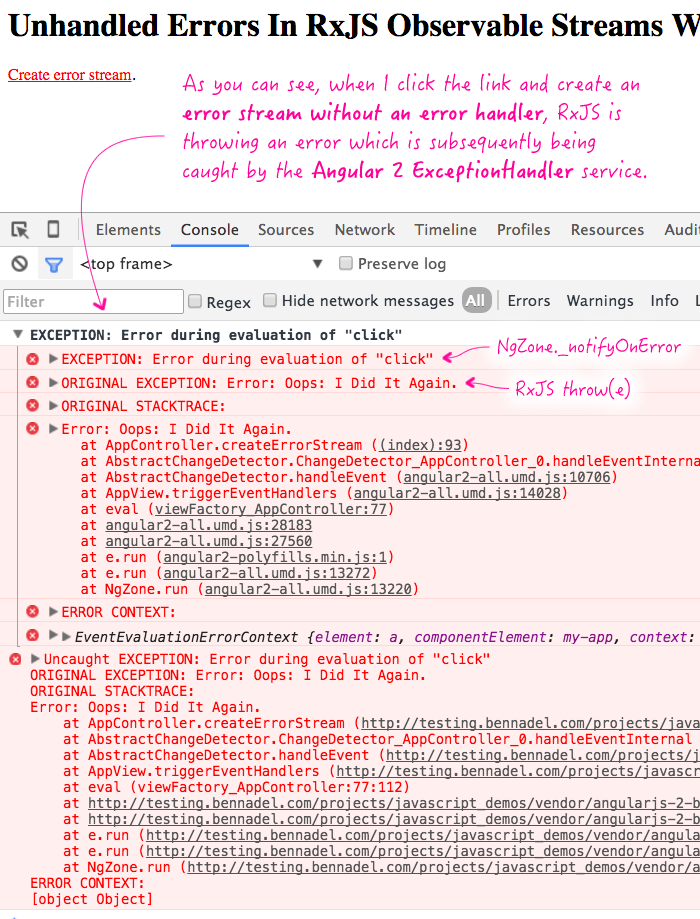Unhandled Errors In RxJS Observable Streams Will Throw Errors In Angular 2 Beta 6
One of the most often cited problems with Promises is that if you don't explicitly handle an error condition in a Promise chain, it's easy to accidentally swallow said error, hiding it from both process and logging. RxJS Observable streams, on the other hand, seem to take a completely different approach. In an RxJS Observable stream, if you don't handle an error condition explicitly, RxJS will handle it implicitly by throwing your error. In Angular 2 Beta 6, the RxJS stream is being managed (so to speak) by the core Zone.js instance which means that these unhandled errors are subsequently caught by the Angular 2 default ExceptionHandler service.
Run this demo in my JavaScript Demos project on GitHub.
To explore this RxJS feature, I put together a tiny little demo that does nothing but create an "error stream" without an error handler (ie, a subscriber that doesn't listen for error events). I also added a few error handling and error conversion functions that you can see in the video:
<!doctype html>
<html>
<head>
<meta charset="utf-8" />
<title>
Unhandled Errors In RxJS Observable Streams Will Throw Errors In Angular 2 Beta 6
</title>
<link rel="stylesheet" type="text/css" href="./demo.css"></link>
</head>
<body>
<h1>
Unhandled Errors In RxJS Observable Streams Will Throw Errors In Angular 2 Beta 6
</h1>
<my-app>
Loading...
</my-app>
<!-- Load demo scripts. -->
<script type="text/javascript" src="../../vendor/angularjs-2-beta/6/es6-shim.min.js"></script>
<script type="text/javascript" src="../../vendor/angularjs-2-beta/6/Rx.umd.min.js"></script>
<script type="text/javascript" src="../../vendor/angularjs-2-beta/6/angular2-polyfills.min.js"></script>
<script type="text/javascript" src="../../vendor/angularjs-2-beta/6/angular2-all.umd.js"></script>
<!-- AlmondJS - minimal implementation of RequireJS. -->
<script type="text/javascript" src="../../vendor/angularjs-2-beta/6/almond.js"></script>
<script type="text/javascript">
// Defer bootstrapping until all of the components have been declared.
// --
// NOTE: Not all components have to be required here since they will be
// implicitly required by other components.
requirejs(
[ /* Using require() for better readability. */ ],
function run() {
var App = require( "App" );
ng.platform.browser.bootstrap( App );
}
);
// --------------------------------------------------------------------------- //
// --------------------------------------------------------------------------- //
// I provide the root App component.
define(
"App",
function registerApp() {
// Configure the App component definition.
ng.core
.Component({
selector: "my-app",
template:
`
<p>
<a (click)="createErrorStream()">Create error stream</a>.
</p>
`
})
.Class({
constructor: AppController
})
;
return( AppController );
// I control the App component.
function AppController() {
var vm = this;
// Expose the public methods.
vm.createErrorStream = createErrorStream;
// ---
// PUBLIC METHODS.
// ---
// I create an RxJS Observable error stream.
function createErrorStream() {
Rx.Observable
.throw( new Error( "Oops: I Did It Again." ) ) // I played with your heart, got lost in the game.
.subscribe(
function handleValue( value ) {
console.log( "handleValue:", value );
}
// NOTE: Uncomment this to handle the upstream error
// and prevent the error from being thrown.
// --
// , handleError
// Notice that we are not providing a CATCH handler in
// our subscriber configuration. As such, the underlying
// Subscriber class is automatically providing one for
// us, which basically implements:
// --
// function handleError( e ) { throw( e ); }
)
;
// I log errors.
function handleError( error ) {
console.warn( "Caught an error in the stream." );
console.log( error );
}
}
}
}
);
</script>
</body>
</html>
As you can see, we're using the .throw() operator to start an error stream; but, we're not catching or handling said error. So, when we run this code and click the link, we get the following console output:

As you can see, the unhandled error was rethrown (for lack of a better term) by RxJS. This thrown error was then caught by Zone.js and piped back into the Angular 2 context where it was subsequently logged by the ExceptionHandler service.
Coming from a Promise background, this behavior kind of caught me by surprise. But, I think this is a really nice feature of RxJS Observable streams. It means that unexpected error conditions will never get lost in an Angular 2 application. Well, not if you're using streams.
Want to use code from this post? Check out the license.

Reader Comments